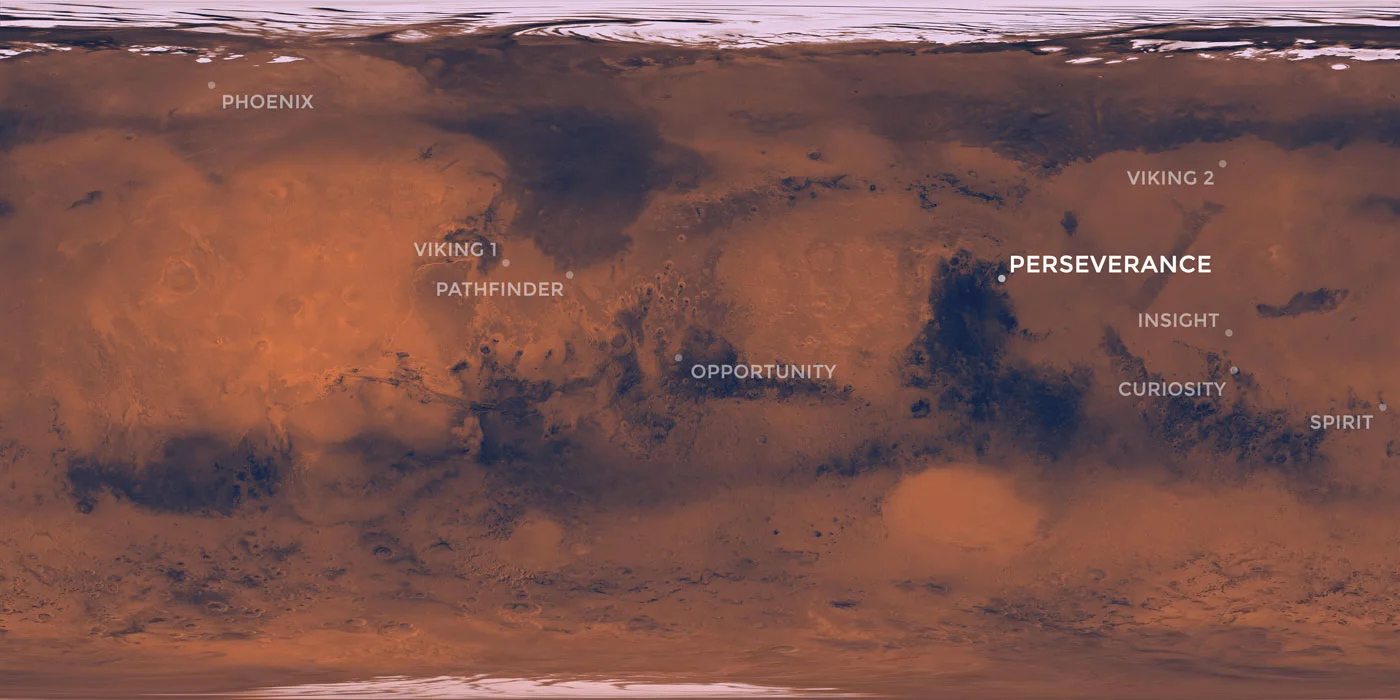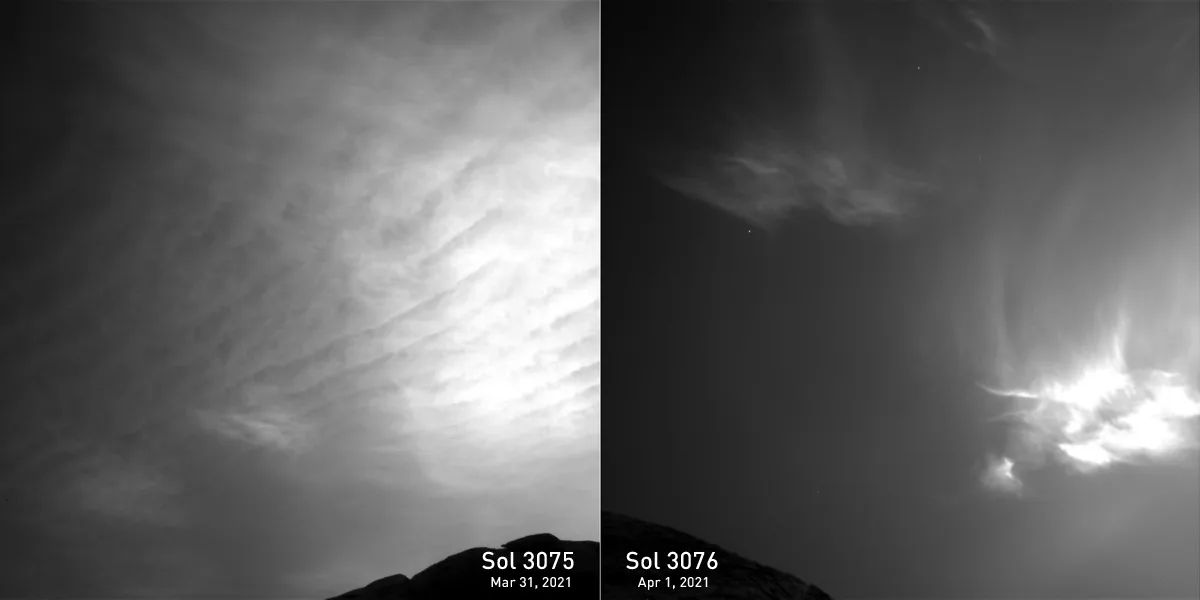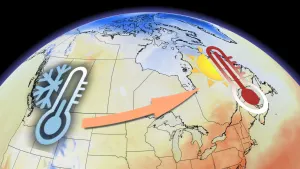
Perseverance's first weather report reveals the extremes of Mars meteorology
The Perseverance rover will help us gain a clear understanding of how weather works on Mars.
Just one day after the Perseverance rover touched down on Mars, it was already giving us its first glimpse of the weather in Jezero crater. So, what's it like there, and what can we expect from this groundbreaking mission?
It's cold on Mars. Very cold.
On February 19, 2021, for the very first time, Perseverance powered up its integrated weather station, known as MEDA, which is short for Mars Environmental Dynamics Analyzer. In just the 30 minutes that the system was active, it recorded a drop in air temperature from -20°C to -25°C. That's not too bad, from a Canadian perspective. Just one week before the landing, Calgary and Edmonton, AB, saw those kinds of temperatures as their daily highs. Their nightly lows got down to around -30°C.
On April 3rd to 4th, though, the rover was sampling the weather of a typical spring day in Jezero crater while the Mars Helicopter, Ingenuity, endured the Martian night all on its own.

This closeup of Ingenuity was snapped by Perseverance on April 5, 2021. Credit: NASA/JPL-Caltech
The daily high temperature measured by MEDA got up to -22°C. While that's certainly cold enough, MEDA also showed that the little drone managed to survive a chilling overnight dip down to -83°C!
"We're very excited to see MEDA working well," Manuel de la Torre Juárez, deputy principal investigator for MEDA at NASA's Jet Propulsion Laboratory, said in a press release on April 6. "MEDA's reports will provide a better picture of the environment near the surface. Data from MEDA and other instrument experiments will reveal more pieces of the puzzles on Mars and help prepare for human exploration. We hope that its data will help make our designs stronger and our missions safer."
TROPICAL MARS WEATHER
Jezero crater is a tropical destination on Mars. It's at roughly the same latitude here on Earth as southern Mexico or the southern part of the Sahara Desert. And Perseverance arrived there just days after the start of Spring in Mars' northern hemisphere.

This map of Mars, compiled from satellite images, shows the locations of all of NASA's landing sites on the planet. Credit: NASA/JPL-Caltech
To find temperatures on this planet like those Ingenuity and Perseverance endured overnight this past week, though, we would need to go all the way to the south pole. On July 23, 1983, in the darkness of southern hemisphere winter, Vostok Station saw a record low of -89.2°C. That stands as the lowest temperature ever recorded on Earth.
Perseverance hasn't experienced its coldest temperatures on Mars yet, though. NASA says that nightly temperatures can get down to -90°C in Jezero crater. Based on what we have already seen from the Curiosity rover, a few thousand kilometres away in Gale Crater, it could get even colder. During winter, Curiosity's REMS instrument has recorded nightly lows below -120°C.
OTHER MARS WEATHER
One of the most remarkable features of Martian weather we see from rover and lander missions is the dust devils.
Just shy of a month after Perseverance landed, the rover's cameras recorded a dust devil passing by in the background of images it had snapped of its 'hand', also known as the 'turret'.
As it turns out, though, the rover's cameras managed to capture a dust devil even before it landed!
On Sol 0 (February 18), a few minutes after first entering the atmosphere, Perseverance was busy snapping pictures of the surface to find a safe place to land. In the process, these vital images also spotted a swirling vortex of dust climbing up the river delta ridge just to the west of where the rover touched down.
Perseverance is the first Mars surface mission from NASA with a camera dedicated to cloud-watching. Appropriately, it's named Skycam, and it is located on the top of the rover's deck.
So far, according to NASA, Perseverance has been seeing fairly clear skies and each of its daily snapshots confirms this. Meanwhile, 3,700 km away, Curiosity has been seeing some fantastic clouds passing by overhead.

Cirrus clouds high above Gale Crater on Mars, imaged by the Right Navigation Camera (Navcam) on NASA's Curiosity rover on Sols 3075 and 3076 (March 31 and April 1, 2021, respectively). Credit: NASA/JPL-Caltech/MSSS/Scott Sutherland
On the right in the above images, Curiosity captured some brilliant Martian cirrus clouds. On the left, it showed off a great example of 'gravity waves'. Not to be confused with 'gravitational waves', gravity waves in meteorology are caused when relatively stable airflow is disturbed, usually by a geographic feature like a mountain (in this case, probably Mt. Sharp, the very mountain the rover is climbing). This causes that flow to rise and fall in a wave-like pattern as it attempts to return to its previous state.
As the airflow is forced upward, it cools. Water vapour condenses out of the air and freezes, forming thin ice crystal clouds. The airflow is then colder than its surroundings, so it sinks, which causes it to warm slightly, suppressing clouds. Buoyancy then takes over and forces the air back up, producing another band of clouds. This pattern continues, again and again, until the air has settled down again.
FLIGHT FORECASTS
Perseverance's weather data is of great interest to Mars scientists. For the next 30 days or so, it will also be critical information for Ingenuity's test flights.
The helicopter's first test flight is currently scheduled for sometime late in the day on Sunday, April 11. NASA is expected to report on the results of that historic test very early on Monday morning. So, stand by for more on this in the days to come!










